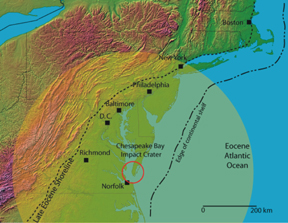 Just over
35 million years ago, an extraterrestrial projectile struck the Eocene Altlantic
Ocean in what is now the Chesapeake Bay near the Delmarva Peninsula of Virginia,
leaving behind a gaping crater twice the size of Rhode Island. If the same sized
asteroid or comet struck the same location today, vast areas of the Eastern
seaboard would be devastated: burnt by the hot vapor fireball, smothered by
the debris thrown out of the crater and ravaged by the atmospheric blast wave.
The size of the projectile is an important key to figuring out what might happen
should an extraterrestrial object strike again. Scientists have gotten a little
closer to figuring that out, with new modeling that reduces the size of the
initial impact.
Just over
35 million years ago, an extraterrestrial projectile struck the Eocene Altlantic
Ocean in what is now the Chesapeake Bay near the Delmarva Peninsula of Virginia,
leaving behind a gaping crater twice the size of Rhode Island. If the same sized
asteroid or comet struck the same location today, vast areas of the Eastern
seaboard would be devastated: burnt by the hot vapor fireball, smothered by
the debris thrown out of the crater and ravaged by the atmospheric blast wave.
The size of the projectile is an important key to figuring out what might happen
should an extraterrestrial object strike again. Scientists have gotten a little
closer to figuring that out, with new modeling that reduces the size of the
initial impact. If an extraterrestrial object were to strike Virginia, like the one that struck in the Eocene some 35 million years ago (the red circle indicates the impact’s region of deformation), much of the Eastern seaboard would be devastated, as shown here in the highlighted area. New modeling of the impact event, which shows that it was smaller than previously thought, could help better predict the effects of future potential impacts. Image courtesy of Gareth Collins.
The crater itself lies beneath water and 500 meters of sediment. Scientists can discern the structure by sending seismic waves through the crater and seeing how the waves travel. On first glance at such seismic reflection data, the Chesapeake Bay crater somewhat resembles the peak-ring craters prevalent on other planets and moons, wrote Gareth Collins of Imperial College London in the United Kingdom and Kai Wünnemann of the University of Arizona in Tucson in the December Geology.
Peak-ring craters have at least two prominent rings — an inner ring and an outer ring — with distinct characteristics, such as raised ridges. On closer inspection of the Chesapeake crater, however, neither ring has the same characteristics as the rings of a typical peak-ring crater, Collins says.
Furthermore, cores drilled into various locations in the crater have shown that the type and amounts of deformed, melted and “shocked” rocks that researchers would expect to see were quite different. For example, the crater’s layer of impact breccia (broken and jumbled rocks) was much thicker than in other craters on Earth or on other planets, and deformation at the edge of the crater was far less than would be expected.
Plugging these unique characteristics into a model, Collins and Wünnemann were able to determine that while the deformation area left in the wake of the impact is 85 kilometers (53 miles) wide, as shown in seismic data, the initial impact itself left a crater only 40 kilometers (25 miles) wide — the diameter of the inner ring. The model suggests that the impact event likely released an amount of energy equivalent to 2 million megatons of TNT — more than 40,000 times the energy released during the 1980 Mount St. Helens eruption. This new evidence could better determine the size of the impactor.
Wylie Poag, a researcher with the U.S. Geological Survey (USGS) in Woods Hole, Mass., says that the new findings reflect the nature of the ocean impact: The impactor struck weak sediments on the seafloor, which deformed more than stronger sediments would have, had the impactor hit land instead. An impact of the same energy on land would have left just the 40-kilometer crater, without the additional deformation out to 85 kilometers.
“If you form a big hole in the ground, and the rock surrounding the hole is strong, the hole will be relatively stable; but if the surrounding rock is weak — more like a saturated soil — the sides will immediately collapse to fill in the hole,” Collins says. That slumping and backfill into the crater is what the researchers think happened following the Chesapeake impact.
Collins and Wünnemann provide “pretty compelling evidence” that the crater is smaller than originally thought, less energy was released, and thus the environmental consequences would have been considerably less, Poag says. Although their model is very good, he says, “ground-truthing will certainly help define the parameters of the crater,” including giving a better idea of the actual temperatures and pressures on the rocks that were struck, which then “helps us figure out the size of the impact.”
That ground-truthing could come from an ongoing project to drill to the center of the crater. USGS and its partners have drilled close to 1,830 meters below the Chesapeake Bay, and will be sending out core samples for analysis beginning this month (see Geotimes, January 2004). “We’re already seeing new sections of rock,” Poag says, which will also help determine exactly what happened 35 million years ago, and what consequences the planet might see if this were to occur again.

